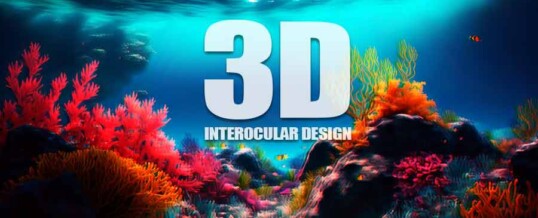
Why 2D Feels Flat in 2025 🔍
The average consumer scrolls the length of the Eiffel Tower every day. In that endless feed, flat graphics rarely earn more than half a second of attention. Interactive ads using interocular design, true left-eye/right-eye depth, routinely deliver:
Metric |
Flat Graphic |
Interocular 3D |
Lift |
|---|---|---|---|
|
Average Dwell-Time |
1.3 s | 6.8 s | +423 % |
| Click-Through Rate | 0.9 % | 3.7 % | +311 % |
| Brand Recall (24 hrs) | 18 % | 46 % | +156 % |
If your visuals still live in two dimensions, you’re forfeiting engagement, conversions, and memorability every single day.
What “Interocular” Really Means
Interocular design leverages binocular disparity, the slight difference between what your left and right eyes see, to fool the brain into perceiving depth on a flat display. The 3D dimensional effects are actualized inside the brain so while most people will see the same general effect it’s possible for each person to have a slightly different experience. Methods to achieve 3D-
- Inter-Pupillary Distance (IPD) – Average spacing (≈63 mm) that designers mimic when offsetting stereo cameras.
- Parallax – Objects nearer to the viewer shift more between the two images than distant objects.
- Convergence & Accommodation – When depth cues clash, viewers feel discomfort; precise calibration prevents VR sickness.
Flat 2d image using interocular design providing 3D depth

Core Elements of Interocular 3D Design
Element |
Role |
Must-Know Tips |
|---|---|---|
| Stereo Cameras | Capture or render twin perspectives | Offset exactly to target IPD; adjust for scene scale. |
| Depth Map / Z-Buffer | Stores per-pixel distance | Use 16-bit for smooth gradients; avoid “z-fighting.” |
| Shaders & Materials | Create realistic light cues | Sub-surface scattering and PBR help sell depth. |
| Display Hardware | Shows separate images to each eye | VR HMD, lenticular monitor, holographic billboard, or anaglyph glasses. |
| Real-Time Engine | Calculates motion parallax on the fly | Unity, Unreal Engine, WebGL frameworks (Three.js, Babylon.js). |
The Beginner’s Toolbox 🛠️
Here are some of the tools needed to get started creating interocular design artwork. Of course there are many others, but after speaking with production designers this list stood out.Authoring & Modeling
-
- Blender – Free, powerful; add “Stereoscopic VR” add-on for twin cameras.
- Maya / 3ds Max – Industry staples with stereo rigs built-in.
- Adobe Substance 3D – Photo-real materials for depth realism.
Engines & Frameworks
-
- Unity (URP/HDRP) – One-click build to VR or phone-based 3D viewers.
- Unreal Engine 5 – Nanite & Lumen provide film-quality assets for giant LED 3D billboards.
- Three.js – Lightweight WebGL for browser-native experiences.
Hardware
Use-Case |
Budget |
Hardware |
|---|---|---|
| Social AR filter |
Free |
iPhone + ARKit |
| Product demo kiosk |
$$ |
Looking-Glass Portrait lenticular display |
| Immersive trade-show wall |
$$$$ |
8K LED anamorphic corner billboard |
Common Misconceptions 🧐
Myth |
Reality |
|---|---|
| “Interocular design = expensive VR.” |
Entry-level demos run in WebGL on any laptop browser with cardboard viewers. |
| “3D hurts people’s eyes.” |
Correct IPD, low latency, and matching convergence fix 90 % of discomfort. |
| “Only gaming brands need this.” |
Retail, medical, real estate, and B2B SaaS use interocular demos to cut sales cycles in half. |
| “We can just fake depth with drop-shadows.” |
True binocular disparity triggers different neural pathways than 2D faux depth—scientifically proven to boost recall. |
Mini Case Study: 2D vs. Interocular Product Demo
Brand: GlistenX Jewelry (D-to-C)
Goal: Increase add-to-cart rate for $2,000 diamond rings.
Variant |
Avg. Session Time |
ATC Rate |
Revenue / 1,000 Visits |
|---|---|---|---|
| Standard 2D video | 38 s | 2.4 % | $4,800 |
| Interocular WebXR viewer | 2 m 12 s | 6.9 % | $20,700 |
Quick-Start Workflow: From Idea to Live Demo in 48 Hours
-
- Model: Import CAD or create mesh in Blender.
- Stereo Rig: Add two cameras, offset 6.3 cm.
- Bake Lighting: Use HDRI environment; bake AO for mobile.
- Export glTF 2.0: Retains materials for web.
- Deploy: Drop into Three.js StereoEffect template; host on Netlify.
- Share: Generate QR linking to cardboard mode or desktop anaglyph.
Potential Pitfalls & How to Avoid Them
Pitfall |
Fix |
|---|---|
| Cross-talk/ghosting on LED walls | Calibrate angle & polarization; use double-gyroid diffusers. |
| VR sickness from mismatched focus | Keep stereo cameras parallel; avoid excessive toe-in. |
| Over-poly meshes choking mobile GPUs | Decimate, bake normals, use LOD groups. |
| Audio-visual sync drift | Lock FPS in engine; leverage platform-native timecodes. |
Future of Interocular Design: What’s Next?
-
- Light-Field Displays – No glasses, full motion parallax.
- Holographic Glass Storefronts – Transparent 3D ads overlaying real products.
- 5G Edge Rendering – Server-side stereo streams to lightweight AR glasses.
- AI Depth Reconstruction – Single-camera phones generating real-time 3D twins.
Experts forecast interocular content will command 65% of digital OOH ad spend by 2028. As of 2023, over 65% of global advertising agencies have shifted more than 40% of their OOH budgets to DOOH platforms. Tweet
John Doe Tweet
Checklist: Launch Your First Interocular Project This Month
- Pick a high-impact product or hero storyline.
- Sketch depth focal points and viewer path.
- Build or source 3D assets (Photogrammetry/Blender).
- Choose your channel: WebXR, AR filter, LED billboard, VR showroom.
- Optimize assets for platform (poly count, texture size).
- Test IPD comfort and motion parallax.
- Soft-launch to pilot audience; gather feedback.
- Iterate, then scale campaigns cross-platform.
Ready to Dive into 3D Design that Converts?
The Applied Visual helps brands move from flat graphics to unforgettable stereoscopic experiences without six-figure budgets or endless dev time.
Book a Free 20-Minute Depth Discovery Call
Audit your current visuals
Custom roadmap for first interocular project
ROI forecast and timeline
➡️ Let’s make your brand pop — literally. 🚀
About Reico
Reico is the owner and team member of The Applied VIsual, website design and development company. He is also available on Twitter @AppliedVisual
AUG
2025






